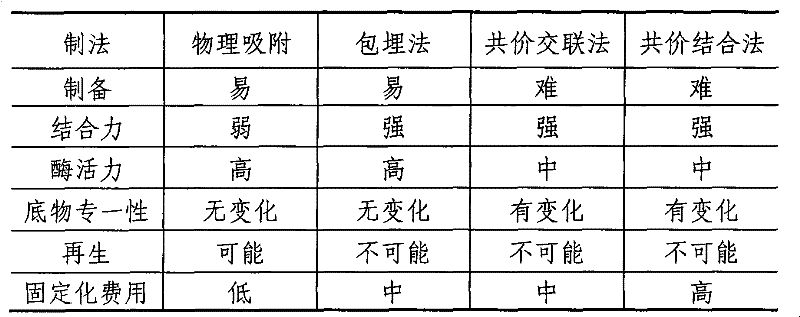Method for preparing immobilized laccase
A technology for immobilizing laccase and laccase, applied in directions such as being immobilized on/in an organic carrier, can solve problems such as difficult preparation and weak binding force, and achieve the effect of solving slow clarification
- Summary
- Abstract
- Description
- Claims
- Application Information
AI Technical Summary
Problems solved by technology
Method used
Image
Examples
Embodiment 1
[0022] Step 1, with CuBr 2 As a catalyst, 2,2'-bipyridine as a ligand, ethyl 2-bromopropionate as a free initiator, and a porous sintered glass ring as a carrier to prepare a porous sintered glass with glycidyl methacrylate graft polymerization function ring, the specific process is as follows:
[0023] First take 5Kg of porous sintered glass ring and add 15L of dichloromethane solvent, then stir and vacuum degassing for 15 minutes, then add 0.5Kg of triethylamine and 1Kg of initiator 2-bromoisobutyryl bromide, and react at room temperature for 24 hours. After the reaction, the solid was separated by centrifugation, washed successively with dichloromethane, tetrahydrofuran and acetone solvents, and vacuum-dried at room temperature to obtain a porous sintered glass ring chemically bonded with the initiator 2-bromoisobutyryl bromide. Then take 2Kg of the porous sintered glass ring and add it to 5L of cyclohexanone solvent, stir and vacuum degassing for 15 minutes, then add 1.5K...
Embodiment 2
[0027] Step 1, with CuBr 2 As a catalyst, 2,2'-bipyridyl as a ligand, ethyl 2-bromopropionate as a free initiator, and a porous sintered glass ring as a carrier to prepare a porous sintered glass with glycidyl methacrylate graft polymerization function ring, the specific process is as follows:
[0028]First take 10Kg of porous sintered glass ring and add 20L of dichloromethane solvent, then stir and vacuum degassing for 15 minutes, then add 1.6Kg of 2-bromoisobutyryl bromide and 1Kg of triethylamine, react at room temperature for 24 hours, and the reaction is over Afterwards, the solid was separated by centrifugation, washed successively with dichloromethane, tetrahydrofuran and acetone solvents, and vacuum-dried at room temperature to obtain a porous sintered glass ring chemically bonded with the initiator 2-bromoisobutyryl bromide. Then take 5Kg of this porous sintered glass ring and add it to 10L cyclohexanone solvent, stir and vacuum degassing for 15 minutes, then add 3Kg...
PUM
 Login to View More
Login to View More Abstract
Description
Claims
Application Information
 Login to View More
Login to View More - R&D
- Intellectual Property
- Life Sciences
- Materials
- Tech Scout
- Unparalleled Data Quality
- Higher Quality Content
- 60% Fewer Hallucinations
Browse by: Latest US Patents, China's latest patents, Technical Efficacy Thesaurus, Application Domain, Technology Topic, Popular Technical Reports.
© 2025 PatSnap. All rights reserved.Legal|Privacy policy|Modern Slavery Act Transparency Statement|Sitemap|About US| Contact US: help@patsnap.com

